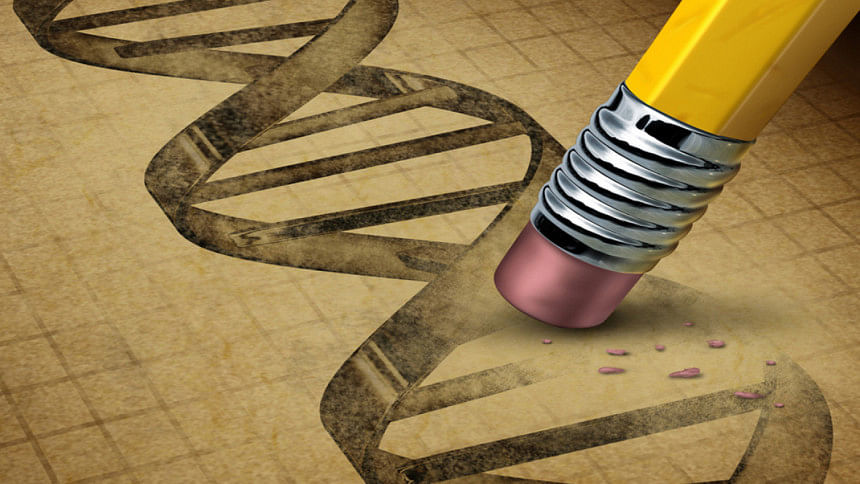Unlocking the potential of genome editing

The science of genome editing is gaining pace with the world's scientific community having greater grasp of the science, its tools, and its potential applications in deriving products for the immense benefits of mankind. To unlock the potential of genome editing, scientists of the relevant fields in Bangladesh need to take further interest in the frontier science, develop knowledge and skills while the media needs to make the public aware of the new science and its potential through popular writings.
Genome editing, or genome editing with engineered nucleases (GEEN) is a type of genetic engineering in which DNA is inserted, deleted or replaced in the genome of a living organism using engineered nucleases, or 'molecular scissors'.
CRISPR-Cas9 (Clustered regularly interspaced short palindromic repeats-assisted system) is currently the simplest, most versatile and precise method of genetic manipulation and is therefore causing a buzz in the scientific world. The world's leading scientific journal, Science, selected CRISPR-Cas9 as 2015's 'Breakthrough of the Year.' CRISPR-Cas9 inventor/s is/are now the most touted candidate/s for the Nobel prize.
Genome is the full complement of genetic information that an individual organism inherits from its parents, especially the set of chromosomes and the genes they carry. This unique technology enables geneticists to edit parts of the genome by removing, silencing, adding or altering sections of the DNA sequence. It has also been used to cure blood disorders like thalassemia and certain cancers.
Jennifer Anne Doudna, Professor of Chemistry, Molecular and Cell Biology of the University of California, Berkeley, has been a leading figure in what is often referred to as the "CRISPR Revolution" for her early fundamental work and ongoing leadership in the development of CRISPR-mediated genome editing. Doudna, along with French microbiology, genetics and biochemistry researcher Emmanuelle Charpentier, were the first to propose in 2012 that CRISPR-Cas9 could be used for programmable gene editing, an idea that has since been further developed by many research groups for applications ranging from fundamental protein research to treatments for diseases including anemia, cystic fibrosis, HIV, etc.
For their genome editing contributions, both Doudna and Charpentier were placed in the Time Magazine's 100 most influential people in the world in 2015. And this year, both of them bagged the prestigious Japan Prize for their original and outstanding achievements in science and technology, and advancing the frontiers of knowledge. Doudna and her co-writers have just published a paper showing the potential of genome editing in the brain to correct or inactivate the underlying genetic causes of neurological diseases. Genome editing experiments have been carried out in the brain of mice.
CRISPR-Cas9 technology has been used to enhance yield of rice grown in drought conditions and to produce fungal blast resistant rice. For example, scientists from China have reported in the Journal Frontiers of Plant Sciences that they have down-regulated the production of abscisic acid (ABA), by cutting a gene responsible for the production of ABA. Lower production of ABA meant that the plant's sensitivity to drought stress was reduced. This has helped increase yield despite the drought condition.
CRISPR-Cas9 system plays the biggest role in research for proving the function of genes. This basic research then leads to applied research and applications. Once the basics of the technology are known, the country's scientists can try out a frontier technology in genome editing.
Some scientists have actively started thinking and acting on using CRISPR-Cas9 system application in their research work. This includes initiatives being taken by the Plant Biotechnology Laboratory at the Department of Biochemistry and Molecular Biology at the University of Dhaka. An international network of scientists, dedicated to the cause of redressing blast attacks in wheat in South America and Bangladesh, are also toying with the idea of applying genome editing so that blast-causing fungi can no longer attack wheat fields. Wheat blast is one of the most fearsome and intractable wheat diseases in recent decades, and the conventional breeding process has so far proven less effective in developing varieties resistant to blast.
Techniques of genome editing in particular CRISPR-Cas9 is also referred to as the 'New Plant Breeding' technology for bringing about necessary genetic changes by using the host genome's own system for systemic incorporation, without having any traces of the vector or transformation marker in the recipients. Therefore in effect, the technology has been deemed similar to genetic mutation which is not subjected to the vigorous oversight that is usual in the case of genetically modified crops. Without the current regulatory oversight, which may take several years, desired crops will be available for use very quickly and thus produce crops which can survive and thrive in the fast-changing climate change scenario. Thus, this is so far the most revolutionary technology of the 21st century impacting plant improvement.
With a goal to expose our scientists to a new world of enormous possibilities, the University Grants Commission (UGC), Krishi Gobeshona Foundation (KGF), University of Dhaka (DU), Faculty of Biological Sciences, DU, National Institute of Biotechnology (NIB) and Bangladesh Council of Scientific and Industrial Research (BCSIR) are helping Global Network of Bangladeshi Biotechnologists (GNOBB) to organise a workshop on CRISPR-Cas9 technology and its application in genome editing later this month. This workshop, organised by GNOBB, is giving the country's scientists a much needed exposure to the highly potential new science. Experts from Japan will be leading this workshop for bench scientists from the agricultural research institutes as well as NIB, BCSIR and public and private universities.
The writer is the Assignment Editor of The Daily Star.

 For all latest news, follow The Daily Star's Google News channel.
For all latest news, follow The Daily Star's Google News channel. 



Comments